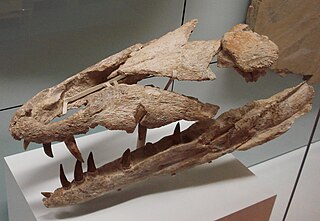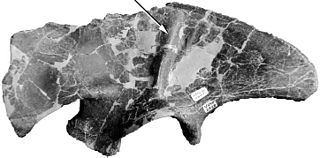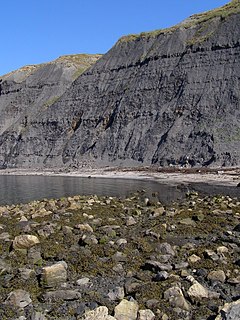
Pliosauroidea is an extinct clade of marine reptiles. Pliosauroids, also commonly known as pliosaurs, are known from the Jurassic and Cretaceous periods. The pliosauroids were crocodile-like short-necked plesiosaurs with large heads and massive toothed jaws. They were sauropterygian swimming reptiles, and were not dinosaurs. They originally included only members of the family Pliosauridae, of the order Plesiosauria, but several other genera and families are now also included, the number and details of which vary according to the classification used.
Liopleurodon is a genus of large, carnivorous marine reptile belonging to the Pliosauroidea, a clade of short-necked plesiosaurs. The two species of Liopleurodon lived from the Callovian Stage of the Middle Jurassic to the Kimmeridgian stage of the Late Jurassic Period. It was the apex predator of the Middle to Late Jurassic seas that covered Europe. The largest species, L. ferox, is estimated to have grown up to 6.4 metres (21 ft) in length.

Dakosaurus is an extinct genus of crocodylomorph within the family Metriorhynchidae that lived during the Late Jurassic and Early Cretaceous. It was large, with teeth that were serrated and compressed lateromedially. The genus was established by Friedrich August von Quenstedt in 1856 for an isolated tooth named Geosaurus maximus by Theodor Plieninger in 1846. Dakosaurus was a carnivore that spent much, if not all, its life out at sea. The extent of its adaptation to a marine lifestyle means that it is most likely that it mated at sea, but since no eggs or nests have been discovered that have been referred to Dakosaurus, whether it gave birth to live young at sea like dolphins and ichthyosaurs or came ashore like turtles is not known. The name Dakosaurus means "biter lizard", and is derived from the Greek dakos ("biter") and σαῦρος -sauros ("lizard").

Aggiosaurus is an extinct genus of geosaurine metriorhynchid crocodyliform known from the Late Jurassic of Nice, southeastern France. It contains a single species, Aggiosaurus nicaeensis, which was named by H. Ambayrac in 1913.

Goniopholis is an extinct genus of goniopholidid crocodyliform that lived in Europe and Africa during the Late Jurassic and Early Cretaceous. Being semi-aquatic it is very similar to modern crocodiles. It ranged from 2–4 metres in length, and would have had a very similar lifestyle to the American alligator or Nile crocodile.

Stokesosaurus is a genus of small, carnivorous early tyrannosauroid theropod dinosaurs from the late Jurassic period of Utah, United States.

The Kimmeridge Clay is a sedimentary deposit of fossiliferous marine clay which is of Late Jurassic to lowermost Cretaceous age and occurs in southern and eastern England and in the North Sea. This rock formation is the major source rock for North Sea oil. The fossil fauna of the Kimmeridge Clay includes turtles, crocodiles, sauropods, plesiosaurs, pliosaurs and ichthyosaurs, as well as a number of invertebrate species.

Machimosaurus is an extinct genus of machimosaurid crocodyliform from the Late Jurassic and Early Cretaceous. The type species, Machimosaurus hugii, was found in Switzerland. Other fossils have been found in England, France, Germany, Portugal, Switzerland and Tunisia. Machimosaurus rex is the largest named teleosauroid and thalattosuchian, with an estimated length of approximately 7.2 metres. Machimosaurus is the largest known crocodyliform of the Jurassic.

Metriorhynchus is an extinct genus of marine crocodyliform that lived in the oceans during the Late Jurassic. The type species, M. brevirostris was named in 1829 as a species of Steneosaurus before being named as a separate genus by the German palaeontologist Christian von Meyer in 1832. The name Metriorhynchus means "Moderate snout", and is derived from the Greek Metrio- ("moderate") and -rhynchos ("snout").

Metriorhynchidae is an extinct family of specialized, aquatic metriorhynchoid crocodyliforms from the Middle Jurassic to the Early Cretaceous period of Europe, North America and South America. The name Metriorhynchidae was coined by the Austrian zoologist Leopold Fitzinger in 1843. The group contains two subfamilies, the Metriorhynchinae and the Geosaurinae. They represent the most marine adapted of all archosaurs.

Enaliosuchus is a dubious genus of extinct marine crocodyliform within the family Metriorhynchidae that lived during the Valanginian stage of the Early Cretaceous. It is known from fossil remains found in France and Germany and it was first described in 1883, making it the first known metriorhynchid described to date. The name Enaliosuchus means "Marine crocodile", and is derived from the Greek Enalios- ("marine") and -suchos ("crocodile"). Two species are known: the type species E. macrospondylus, described in 1883, and the second species E. schroederi, described in 1936, which was likely the same animal as E. macrospondylus.

Geosaurus is an extinct genus of marine crocodyliform within the family Metriorhynchidae, that lived during the Late Jurassic and the Early Cretaceous. Geosaurus was a carnivore that spent much, if not all, its life out at sea. No Geosaurus eggs or nests have been discovered, so little is known of the reptile's lifecycle, unlike other large marine reptiles of the Mesozoic, such as plesiosaurs or ichthyosaurs which are known to give birth to live young out at sea. Where Geosaurus mated, whether on land or at sea, is currently unknown. The name Geosaurus means "Mother of Giants lizard", and is derived from the Greek Ge- and σαῦρος -sauros ("lizard"). The name Geosaurus was established by the French naturalist Georges Cuvier in 1824.

Crocodylomorpha is a group of archosaurs that includes the crocodilians and their extinct relatives. They were the only members of Pseudosuchia to survive the end-Triassic extinction.
Cricosaurus is an extinct genus of marine crocodyliforms of the Late Jurassic. belonging to the family Metriorhynchidae. The genus was established by Johann Andreas Wagner in 1858 for three skulls from the Tithonian of Germany. The name Cricosaurus means "Ring lizard", and is derived from the Greek Cricos- ("ring") and σαῦρος -sauros ("lizard").

Steneosaurus is a dubious genus of teleosaurid crocodyliform from the Middle or Late Jurassic of France. The genus has been used as a wastebasket taxon for thalattosuchian fossils for over two centuries, and almost all known historical species of teleosauroid have been included within it at one point. The genus has remained a wastebasket, with numerous species still included under the label ‘Steneosaurus’, many of which are unrelated to each other.

Nannopterygius is an extinct genus of ophthalmosaurid ichthyosaur that lived in the Middle Jurassic to the Early Cretaceous. Fossils are known from England, Russia, and Norway.

The Solnhofen Plattenkalk, a collective term of multiple Late Jurassic lithographic limestones in southeastern Germany, is famous for its well preserved fossil flora and fauna dating to the late Jurassic.

Torvoneustes is an extinct genus of metriorhynchid thalattosuchian. It is known from skull and postcranial remains found in the Kimmeridge Clay Formation of Dorset and Wiltshire, England, and also from Oaxaca, Mexico . The holotype skull of the type species was initially assigned to the species Metriorhynchus superciliosus. Postcranial remains were later discovered from the same quarry as the skull, and then these specimens were recognised as belonging to a new species of Dakosaurus, as D. carpenteri. The species was named to honour Simon Carpenter, an amateur geologist from Frome in Somerset, who discovered the fossils.

Metriorhynchinae is a subfamily of metriorhynchid crocodyliforms from the late Middle Jurassic to the Early Cretaceous of Europe, North America and South America. Named by Fitzinger, in 1843, it contains the metriorhynchids Metriorhynchus, Gracilineustes, Cricosaurus, Maledictosuchus and Rhacheosaurus. The last three taxa form a tribe within Metriorhynchinae, the Rhacheosaurini. Metriorhynchinae is one of two subfamilies of Metriorhynchidae, the other being Geosaurinae.

Lemmysuchus is a genus of machimosaurid thalattosuchian from the Middle Jurassic Callovian of England and France. Like many other teleosauroids from Europe, it has had a convoluted taxonomic history.





















